An island nation in the Pacific Ocean, some 800 km east of the Philippines. It is geographically part of the larger island group of Micronesia. The picturesque Rock islands has always been my dream destination since I started diving. It has taken me 13 years to finally set foot on the islands. Palau gained full independence in 1994 under a Compact of Free Association with the United States but US still provide financial assistance to them and they remain using US Dollar as their currency. Most tourist can receive free 30-days tourist visa on arrival.
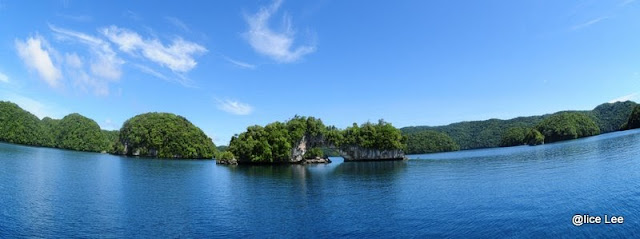 |
| Rock Islands |
To get there, there is no other way than plane. There is only one airport, Airai (ROR), on Babeldaob Island. Continental Airlines has twice a week flights from Manila, Philippines. Good for us we can catch one of the many low cost airline to Manila and connect to Palau. The flight itself from Manila to Palau is very expensive and the security is very tight, I still remember they were checking every single screw I had for my underwater housing and even our footwear.
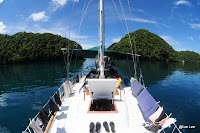 We have chartered The Eclipse, a 48' classic ocean sailing yacht exclusively for the 5 of us for a 6 days LOB dive trip. The 5 of us has been diving together for a while so we know each other very well, because the yacht is not very big, it is advisable that we travel in a small group and with people we are comfortable with to avoid throwing someone off the boat. :-)
We have chartered The Eclipse, a 48' classic ocean sailing yacht exclusively for the 5 of us for a 6 days LOB dive trip. The 5 of us has been diving together for a while so we know each other very well, because the yacht is not very big, it is advisable that we travel in a small group and with people we are comfortable with to avoid throwing someone off the boat. :-)  |
| Eclipse |
There is a price to pay diving on a yacht, there is no dive deck or dive platform. We have to make do with setting up our equipment by the side of the boat and then leave everything lying down on the open space at the fore deck of the boat. We jump off the 1m high side deck and climb back up using a very small ladder. Nevertheless, Eclipse has all the essentials for dive expeditions, with generator, dive compressor, inflatable launch with outboard, charging stations for cameras and laptops.
 |
| Engines for Zeke fighters |
 The next day we sail through the famous German Channel. Why is it called the German Channel? This man-made channel was blasted out by German miners, in the early 1900s, to allow their boats easy access from the inner lagoon to the open sea to bring the guano(bird shit) to town, for trans-shipment to Europe. Over the years, it has become much narrower as coral formations have developed and now live-aboard vessels often have difficulty navigating it unless the tide is right. German channel is known for Manta Rays and schooling sharks. During the incoming tide Manta Rays can often be seen inside the shallow channel. We saw a dozen of them swimming into the cleaning station where wrasse and cleaning fishes were on standby. It was breathtaking!
The next day we sail through the famous German Channel. Why is it called the German Channel? This man-made channel was blasted out by German miners, in the early 1900s, to allow their boats easy access from the inner lagoon to the open sea to bring the guano(bird shit) to town, for trans-shipment to Europe. Over the years, it has become much narrower as coral formations have developed and now live-aboard vessels often have difficulty navigating it unless the tide is right. German channel is known for Manta Rays and schooling sharks. During the incoming tide Manta Rays can often be seen inside the shallow channel. We saw a dozen of them swimming into the cleaning station where wrasse and cleaning fishes were on standby. It was breathtaking!We also got a chance to troll for big fish while cruising. Andy caught a huge Spanish Mackerel to top up as fresh sashimi, fish congee, sweet sour fish and fish soup for us. Charlie is the best that we had on board, she made amazing Thai and Chinese cuisines. She just surprised us with every meals. She is also an excellent dive master. The entertaining part on board was to watch the drama between her and John, we just can't stop laughing about it. :-)
 |
| Blue Hole |
Last but not least, we visited the Jelly fish lake. Swimming in thousands of stingless jellyfish (although both species of jellyfish living in the lake have stinging cells) was so much fun. This was my second time swimming in a Jelly fish lake, first was in Kakaban, Indonesia but here there are more jellyfish but only 2 species compare to 4 species in Kakaban.
What is my take about Palau? Yes Palau is the BEST place to dive. It has so much varieties, from seeing manta, sharks, wrecks, wall, cave or simply just snorkel in the jelly fish lake. It is my BEST dive destination thus far.
Travel date : 10-17 Nov 2010
Travel route : SG -F-> Manila -F-> Palau
Type of diving : Wreck, Reef, Wall, Cave
Water temperature : 28-30°C
Best time to dive : Excellent year round, the best diving season is considered to be between late November and early June.
-F-> Flight -B-> Boat







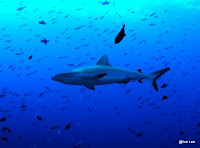

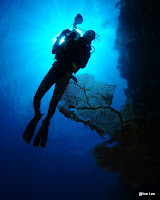

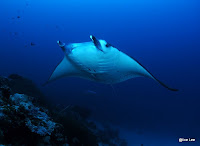


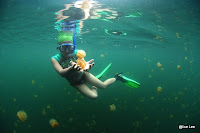
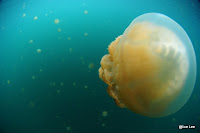
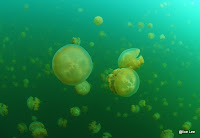


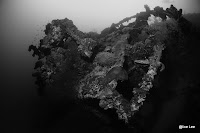


No comments:
Post a Comment